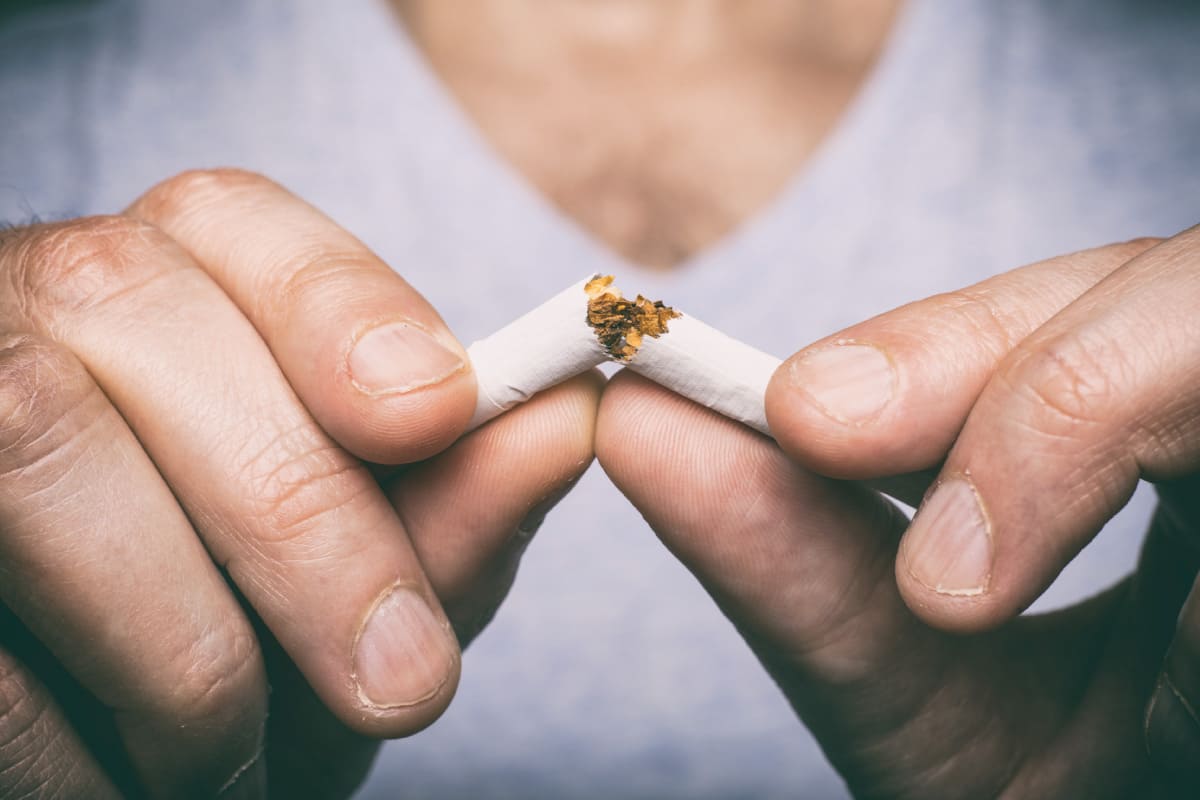HOW LONG DOES NICOTINE STAY IN YOUR SYSTEM?
Nicotine is largely cleared out of the body after 3 days of not smoking, but it is detectable using a variety of tests (such as urine or blood tests) long after stopping. It is detectable in saliva of heavy smokers for up to 5 days, but hair tests can detect tobacco use with a high level of accuracy for up to 3 months and detect nicotine in hair for up to a year.
INTRODUCTION
There are a few reasons for why you might be interested to know how long nicotine stays in your system. Nicotine tests are sometimes used for medical purposes when it comes to insurance, but the big one many smokers want to know is ‘when will the withdrawal symptoms stop?’
It’s a fair question, and knowing the answer may help to fortify quitters in their journey to giving up smoking. After all, once you have cleared nicotine from your system, the only remaining compulsion to smoke is the psychological desire that may hit when around people who smoke, or engaging in activities that you enjoyed smoking with - like drinking alcohol.
WHAT IS NICOTINE?
America’s FDA (Food and Drug Association) describes nicotine as ‘a highly addictive chemical compound present in the Tobacco plant.’ It is a natural insecticide, but when ingested by humans it acts as both a stimulant and depressant - it stimulates areas of the brain that regulate processes that control our mood and cognition, as well as stimulating the production of hormones that reduce tiredness - but studies suggest that smaller doses encourage the sedative effect, reducing anxiety and anger.
It is this seemingly at-odds combination of effects that keeps people coming back, as at times of stress a cigarette may help to relax you; when lacking focus and unable to concentrate, the nicotine from a cigarette activates areas of the brain that control and promote cognition, giving the smoker a sense of mental acuity.
Having been stimulated by nicotine, the brain becomes reliant on this external input, so failing to re-dose leaves the person in a deficit, and this is withdrawal. Physical and psychological withdrawal symptoms occur, ranging from: insomnia, headaches and sweating to anxiety, irritability and depression. The litany of withdrawal symptoms makes it easy to understand why people keep coming back to nicotine - when you are ‘on the hook’ it helps you concentrate, and continued use keeps the withdrawal symptoms away.
This is why E-Cigarettes are a great way to quit smoking - you still get your nicotine but without 95% of the harm associated with tobacco cigarettes. As long as you use UK-made liquids, whatever device you choose to use, from box mods to POD vapes, it is around 95% less harmful than smoking according to Public Health England.
WHAT FACTORS DETERMINE THE DETECTION TIME OF NICOTINE?
Nicotine gets around the body via the bloodstream, binding at sites including the liver, kidney, spleen, and brain, and is lowest in fat tissue. It is worth noting that as a smoker, your brain develops more nicotinic acetylcholine receptors (this is where the nicotine binds), which may explain why it is harder to give up cigarettes for an extended period of time.
Nicotine is broken down, or ‘metabolised’, by the liver, where 70-80% is turned into cotinine. One of the other forms nicotine is broken down into is known as Nicotine N’-oxide, and while only a small amount of this is made from the nicotine, it can be reduced back to nicotine in the intestines, which suggests the body could be recycling the nicotine!
As the liver is the primary metabolising force when it comes to nicotine, any activities that affect liver function will affect the liver’s ability to get rid of the nicotine in the blood. After eating a meal, blood flow to the liver increases by about 30%, resulting in an increase in the elimination of nicotine from the blood (1).
The primary enzyme responsible for metabolising nicotine is designated P450 (CYP) 2A6, and studies show genetic differences that cause variations in this enzyme from person to person - and these differences can affect the speed at which nicotine is broken down by up to half! Ethnic backgrounds also present differences in the way cotinine is formed, and generate variations in the P450 (CYP) 2A6 enzyme (2).
There are notable differences between men and women too - women experience higher nicotine clearance, and this increases further if they are taking oral contraceptives or are pregnant. The main difference appears to be a result of a faster metabolism in women than in men.
Age also affects how long nicotine can stay in your system. Over the age of 65, total nicotine clearance was 23% lower and renal clearance (processed and excreted by the kidneys) was 49% lower. It is suggested that this is down to reduced blood flow to the liver at this age.
Drinking lots of water is also beneficial when it comes to getting nicotine out of your body - both nicotine and its metabolite, cotinine, are water soluble, and so drinking lots of water not only helps get them out of your system, but the increased frequency of urination will encourage more nicotine and its metabolites to be excreted (3). Hydrating is also a great way to stave off and deal with several nicotine withdrawal symptoms during smoking cessation. Exercise is another way that helps in this fashion, as sweating will help excrete toxins, as well as increasing your metabolic rate, improving the speed at which nicotine and its metabolites are processed. Just make sure to drink plenty of water to keep these mechanisms working!

A variety of medications can also contribute to the processing of cotinine and nicotine; as mentioned oral contraception for women increases nicotine clearance. Some anticonvulsant drugs also appear to increase the amounts of P450 (CYP) 2A6 protein, inducing more nicotine clearance. An antimalarial drug called ‘artemisinin’ has also been studied and the results suggest it induces more P450 (CYP) 2A6 activity. Conversely, there are various chemicals that behave as enzyme inhibitors, like tryptamine, that reduce the levels of processed nicotine - this means more nicotine present in the blood which actually reduces cravings.
The act of smoking itself affects the rate at which the body metabolises nicotine. Smoking increases the rate at which the body metabolises a variety of other drugs, but this does not appear to be the case with nicotine! Studies have shown that nicotine clearance was significantly lower in smokers, and having tested if cotinine levels and carbon monoxide were having this effect and finding it not to be the case, it could be that there is something else in tobacco smoke that inhibits the clearance of nicotine.
While there isn’t strong evidence on the matter, there is evidence suggestive of a negative correlation between BMI and the ability to metabolise nicotine - this means a higher BMI might slow your ability to flush nicotine from your system.
HOW IS THE PRESENCE OF NICOTINE IN THE SYSTEM DETECTED?
Nicotine tests are either qualitative or quantitative - i.e they can test whether nicotine is present, or they can test for the concentration (amount) in your body. These include hair testing, blood testing, saliva testing and urine testing.
The quantitative test gives more information, and the results can show if someone is currently a smoker or has recently quit. Strictly speaking, the tests often look for cotinine and not nicotine because cotinine is more stable and lasts longer in the body, and is only present after nicotine is broken down (4).
In the event someone who has quit tobacco products using nicotine replacement therapy, such as nicotine gum or nicotine patches, needs to be tested for whatever reason, anabasine is the chemical they look for because it is a tobacco specific alkaloid not present in NRT products.
There are a variety of reasons why you might need to take a nicotine test; obviously studies investigating nicotine in the body need to use tests to gather the information, but other reasons could include applying for health and/or life insurance, court ordered testing, for employment purposes, or if you are exhibiting symptoms of a nicotine overdose.
Urine tests are used to detect long term tobacco usage because nicotine and cotinine will stay in your urine longer than in the blood, with the metabolite of nicotine ‘cotinine’ found for several weeks after giving up tobacco.
Blood tests for nicotine can detect if you have used tobacco products within 2 weeks, using a test called ‘quantitative liquid chromatography - tandem mass spectrometry’ - a combination of 2 techniques working together. Blood testing allows separation of the components within the liquid (liquid chromatography) and then identifies the components from their structure (mass spectrometry).
Saliva tests are useful for testing recent use, and are accurate enough to detect nicotine in much lower concentrations, but there is variation between types of smokers and how long nicotine can still be found in the saliva: light or casual smokers may find no nicotine in their saliva after 11 hours, but in heavy smokers nicotine can stay in the saliva for up to 5 days (5).
The last form of test available is a hair test. Hair testing is reliable when it comes to long term tobacco consumption, maintaining a high level of accuracy for up to 3 months after cessation, and is capable of detecting nicotine in hair for up to 12 months.
IS IT POSSIBLE TO CLEAR NICOTINE FROM THE BODY AND MAKE IT NOT LAST AS LONG?
It is possible to clear nicotine from the body, but how much nicotine you consume determines how long nicotine takes to clear from the body and get back to ‘normal’. For smokers, this can take around 3 months as smoking changes the brain chemistry. There are products available that claim to help speed up your nicotine detox, but there is little evidence to suggest these actually work!
Smoking forms free radicals which are reactive molecules that are unstable and can cause damage in the body, but foods rich in antioxidants - dark chocolate and blueberries to name a couple - react with these chemicals to neutralise them and prevent them from causing damage. Further than this, taking in tobacco smoke reduces the amount of vitamin C in your body, as well as impeding the absorption of other important nutrients like calcium and vitamin D. Making sure to eat plenty of fruit and veg will replenish these nutrients, and may reduce cravings because of this. This study showed the antioxidant defence system is negatively affected by smoking, and therefore taking steps to improve this may well improve the immune system, contributing to a better sense of wellbeing and ability to handle the stress of nicotine withdrawal (6).
Ginseng has also shown it could be useful when it comes to quitting, and even relapsing - it stops the release of dopamine by nicotine, and binds to the dopamine receptors, lessening the dopamine hit from smoking. This means nicotine won’t feel as rewarding as it has done in the past, hopefully reducing the psychological desire to light up!
As mentioned before, increased water intake results in more frequent urination, which leads to more opportunity for nicotine to leave your system. Keeping hydrated not only helps concentration, but allows for some good exercise, which increases your metabolic rate (and therefore the speed you metabolise nicotine) - and sweating is another opportunity for nicotine to get out of your system! Exercise will also help you get off to sleep, reducing insomnia symptoms when quitting nicotine.
HOW LONG DOES NICOTINE STAY IN YOUR SYSTEM - CONCLUSION
The hard reality is: there is no quick way to clear nicotine from your body. There are several mechanisms which can help speed you along a bit faster, and improving your diet and exercise will help take the edge off the withdrawal, in addition to helping clear nicotine from the body. Just remember, how much nicotine your body is used to taking in will impact how quickly your body can clear it from the system.
Using an
e-cigarette starter kit is a great way of reducing your nicotine in a manageable way as you can work your way from the strongest available strength all the way down to 0% nicotine, tackling the nicotine dependency and the ritual of smoking. Over time this can lead to a reduction in the number of nicotine receptors in the brain - and it is the large number of these receptors in smokers that contributes to withdrawal because the activation of these receptors is what triggers the effects of nicotine. These extra receptors don’t disappear for up to 6 weeks after kicking the habit - which is why going ‘cold turkey’ is so challenging!
Giving up could prove to be much easier if you have been on a low nicotine e-liquid for a while, and eliminating the other chemicals in tobacco may help speed up the processing of nicotine in the body - so why not give SMOKO a call and make the switch to an e-cigarette today!
REFERENCES
(1) Food and nicotine metabolism
(2) Interindividual variability in nicotine metabolism: C-oxidation and glucuronidation
(3) Does Drinking Water Flush Nicotine Out of Your System?
(4) Nicotine Exposure and Metabolites
(5) How Long Does Nicotine Stay In Your Saliva?
(6) Antioxidant status and smoking habits: relationship with diet
ABOUT THE AUTHOR
Written by Dan Overgage
Dan Overgage – is a former smoker of 10 years until he became a client of SMOKO E-Cigarettes. Dan started working with SMOKO 5 years ago after successfully quitting using our e-cigarettes and works across our Customer Service and heads up our content creation and research with a strong focus on all things quitting smoking. During his tenure with SMOKO, Dan has written countless blogs and consults with countless clients every day to help them to stay smoke-free.











